- Clinical Technology
- Adult Immunization
- Hepatology
- Pediatric Immunization
- Screening
- Psychiatry
- Allergy
- Women's Health
- Cardiology
- Pediatrics
- Dermatology
- Endocrinology
- Pain Management
- Gastroenterology
- Infectious Disease
- Obesity Medicine
- Rheumatology
- Nephrology
- Neurology
- Pulmonology
Pain Is Here, There, and Everywhere: A Photo Essay
Chronic pain and psychological interventions, complex regional pain syndrome, spinal fractures and low back pain, acute gouty arthritis, Chiari I malformation, Dengue fever, erythema nodosum-a look at pain in its many shapes, sizes, and locations.
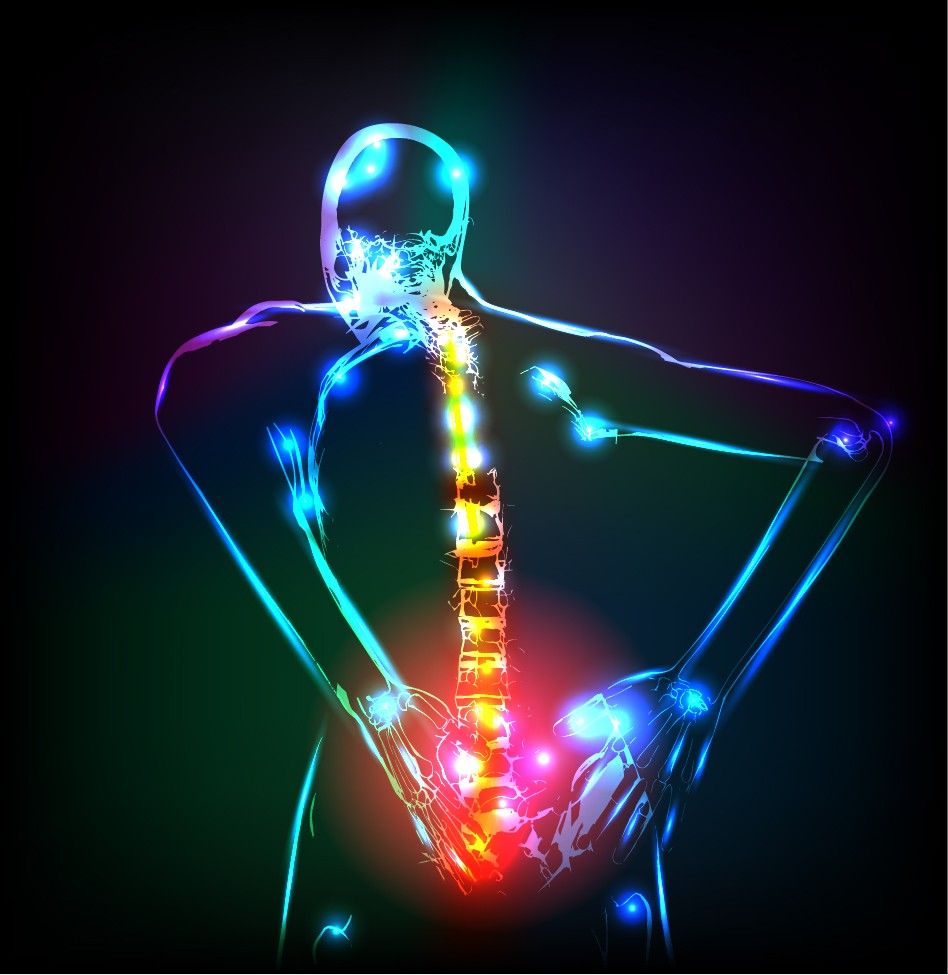
Case 1:
The years of life lost to illness is not the only way the relative impact of diseases on national health should be viewed, suggests ConsultantLive editorial board member Steven A. King, MD.
A recent study looked at the overall health burden in terms of disability-adjusted life years, taking into account the effect of potentially fatal diseases by measuring years lost to premature mortality and the effect of more chronic disorders measured by years living with a disability.
• The leading years-lost-to-premature-mortality diseases: ischemic heart disease, lung cancer, stroke, and chronic obstructive pulmonary disease.
• The leading years-living-with-a-disability diseases: low back pain, major depressive disorder, other musculoskeletal disorders, neck pain, and anxiety disorders.
There is significant comorbidity between chronic pain and depressive and anxiety disorders. Pain can be a presenting symptom, and the experience of chronic pain can lead to their development.
These years-living-with-a-disability disease categories may represent different presentations of similar disease processes and may suggest addressing physical pain and psychological factors together, not as separate issues. Greater use of early psychological interventions in cases of low back pain and other types of pain that may become chronic might help reduce the disease burden.
NEXT CASE »
For the discussion, click here.
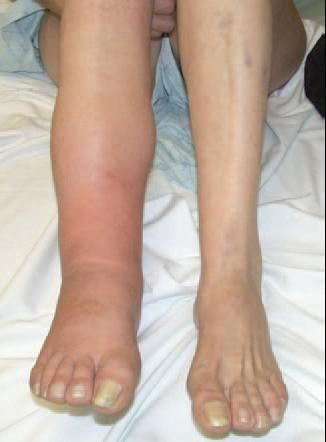
Case 2:
Complex regional pain syndrome (CRPS) arises after fractures and other injuries and may occur after orthopedic surgery. Inflammatory processes and a pattern of disuse may be more important than previously thought. CRPS has the following stages:
• Radiographic findings are normal, and symptoms arise that are subjective in nature: pain, hyperesthesia, increased sweating, and cold-heat intolerance.
• Around months 3 to 6, symptoms are marked by edema, cold glossy skin, loss of motion, and hair loss. Osteopenia begins to appear on x-ray films.
• Muscles and skin begin to atrophy. Other symptoms include hair loss, brittle nails, severe contracture, and advanced demineralization on x-ray films.
Early diagnosis and aggressive treatment are important. Clinicians should be aware of disproportionate pain, symptoms that are not confined to a specific nerve distribution, hyperesthesia, trophic changes, and restricted motion.
Text courtesy of Nicolai Baecher MD, Thomas Sanders MD, and Michael Kessler MD
NEXT CASE »
For the discussion, click here.
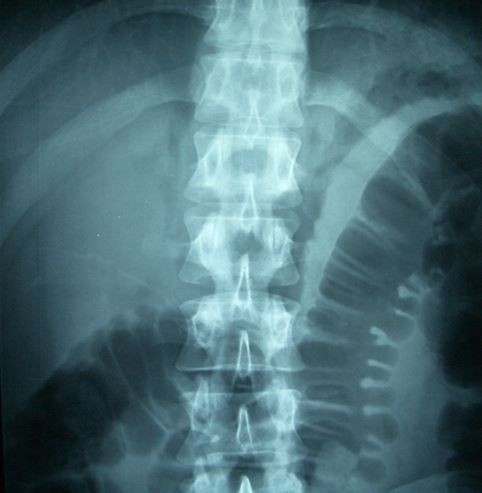
Case 3:
A 38-year-old man slips while rushing down hardwood stairs wearing socks and falls hard onto the stairs, injuring his back. He is having difficulty walking because of right-sided low back pain that radiates up his back and down to his thigh when he tries to stand.
On physical examination, vital signs are all normal except for the man’s blood pressure, which is elevated at 147/81 mm Hg, most likely a result of pain. His head and neck are nontender and atraumatic. His upper back is nontender, but his lower back is tender.
On spinal films, the lateral view findings are normal. The anteroposterior view is shown here. There is a fracture of the right lateral spinal process or the first lumbar vertebra.
Spinal fractures most often are caused by falls, motor vehicle accidents, and sports injuries. Unstable lumbar spinal fractures are more severe than stable fractures, typically involving 2 of the 3 spinal columns (anterior, middle, and posterior), and there is a significant risk of spinal cord injury. Stable fractures are extremely unlikely to be associated with spinal cord injury.
Case and image courtesy of Brady Pregerson, MD
NEXT CASE »
For the discussion, click here.
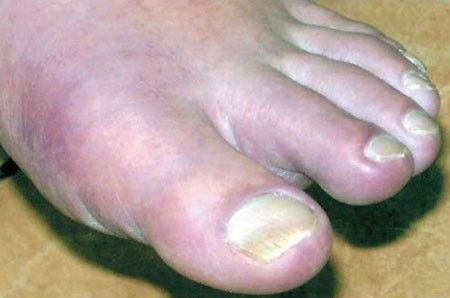
Case 4:
Gout, the “disease of kings,” is a leading pain disorder and one of the most painful forms of arthritis.
The diagnosis of acute gouty arthritis often is missed or made late in its clinical course. The classic presentation of an initial flare is acute inflammatory monoarthritis in a middle-aged man. About 90% of initial attacks are monoarticular; 50% occur in the first metatarsophalangeal joint of the great toe. Other sites include the instep/forefoot, ankle, knee, wrist, and fingers.
Severe pain, redness, and swelling develop rapidly, and inflammation peaks within 1 day. When the attack occurs in the toe or foot, patients often cannot wear socks, and even the mere touch of a bed sheet may cause extreme pain.
Risk factors for gout include family history, older age, renal insufficiency, use of medications that reduce urate excretion, high intake of foods that increase urate production, and comorbidities (eg, obesity and metabolic syndrome).
Chronic gouty arthritis develops in patients who have had acute attacks of gout for years.
NEXT CASE »
For the discussion, click here.
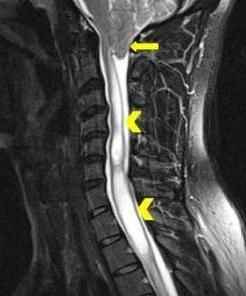
Case 5:
A 29-year-old man presented with a 4-year history of headache and severe neck pain. The neck pain-constant, dull, and achy-radiated up to the posterior scalp and down both shoulders and sometimes was accompanied by occipital headaches. The headaches and neck pain increased in intensity with coughing, lifting, and exercising.
On the visual analog scale, the patient reported a pain level of 6 on a scale of 0 to 10. On palpation, there was paraspinal and bony prominence tenderness.
No abnormalities were seen on a flexion-extension radiograph of the cervical spine. This cervical MRI scan without contrast revealed a Chiari I malformation with herniation of the cerebellar tonsils measuring up to 2.7 cm (arrow) and extensive syringomyelia (arrowheads).
Chiari I malformation is characterized by herniation of the cerebellar tonsils at least 5 mm below the foramen magnum. The exact cause is unknown, but headaches and neck pain-the most common presentation-are thought to be caused by irritation of the meninges.
The symptoms of Chiari malformation can be broad, but they may be similar to symptoms seen in patients with obstructive hydrocephalus or cerebellar deficits.
Case and image provided by Jason J. Song, MD, PhD and Franklin E. Caldera, DO
NEXT CASE »
For the discussion, click here.
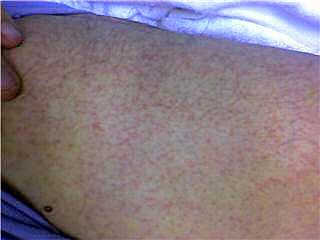
Case 6:
The patient, a 43-year-old businessman, complains of fever, rash, headaches, and body aches. His symptoms all wax and wane and have been present for 3 days. His examination is unremarkable except for the rash, which is all over his body.
The diagnosis is Dengue fever, a painful, debilitating mosquito-borne disease. Dengue fever is caused by a flavivirus transmitted by the Aedes mosquito. It is frequently contracted in the Caribbean islands as well as in Latin America and Southeast Asia.
The clinical presentation of Dengue fever involves high spiking fevers associated with severe body aches. The intense pain gives it the nickname of “breakbone” fever. There also may be severe headache.
Case and photo courtesy of Brady Pregerson, MD
NEXT CASE »
For the discussion, click here.
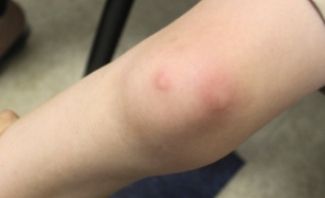
Case 7:
A 5-year-old boy presented with these nonpruritic, nonsuppurative painful erythematous nodules on his lower extremities. The rash appeared about 1 week after the onset of a dry hacking cough. He had a low-grade fever and joint pain and effusions in his right knee and elbow.
The lesions increased in number and progressed to larger painful, indurated nodules that covered his lower extremities, ankles, and places on his arms and hands.
A chest x-ray film showed peribronchial changes consistent with bronchitis. A sputum culture was positive for Mycoplasma.
The diagnosis was erythema nodosum (EN), the most common panninculitis, thought to be a delayed hypersensitivity response to foreign antigens, often respiratory tract pathogens.
EN typically manifests as painful bilateral pretibial nodules after a febrile illness. Nodules most often develop bilaterally on the anterior surfaces of the legs but can occur anywhere and are often associated with joint pain and swelling.
Suspected causes of this painful disorder include bacterial infections, fungal infections, enteropathies, Behcet disease, tuberculosis, Hodgkin disease, and sarcoidosis.
Case and photo provided by Shannon Etheridge Whitten Ms, NP-C
